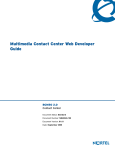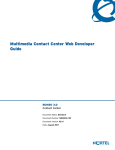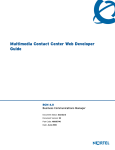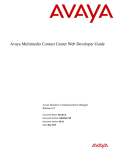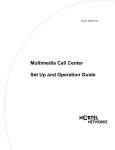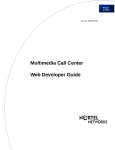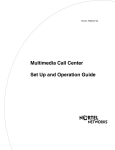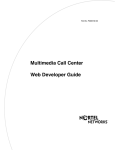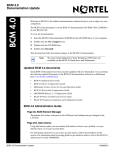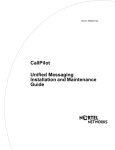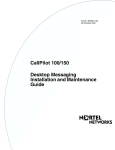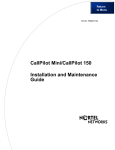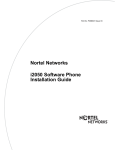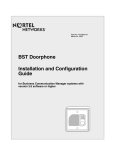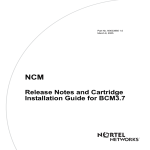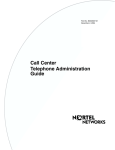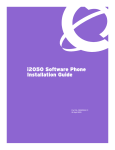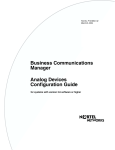Download Avaya Multimedia Call Center User's Manual
Transcript
Part No. P0935740 07 23 March 2004 Multimedia Call Center Web Developer Guide 2 Multimedia Call Center Web Developer Guide Copyright © 2004 Nortel Networks All rights reserved. 2004. The information in this document is subject to change without notice. The statements, configurations, technical data, and recommendations in this document are believed to be accurate and reliable, but are presented without express or implied warranty. Users must take full responsibility for their applications of any products specified in this document. The information in this document is proprietary to Nortel Networks NA Inc. The software described in this document is furnished under a license agreement and may be used only in accordance with the terms of that license. The software license agreement is included in this document. Trademarks NORTEL NETWORKS is a trademark of Nortel Networks. Microsoft, MS, MS-DOS, Windows, and Windows NT are registered trademarks of Microsoft Corporation. All other trademarks and registered trademarks are the property of their respective owners. P0935740 07 3 Contents Chapter 1 About Multimedia Call Center . . . . . . . . . . . . . . . . . . . . . . . . . . . . . . . . . . . . . 5 Prerequisites for customizing Multimedia Call Center web pages . . . . . . . . . . . . . . . . . 5 How to get help . . . . . . . . . . . . . . . . . . . . . . . . . . . . . . . . . . . . . . . . . . . . . . . . . . . . . . . 6 Chapter 2 Integrating Multimedia Call Center with a website . . . . . . . . . . . . . . . . . . . . 9 Multimedia Call Center Call types . . . . . . . . . . . . . . . . . . . . . . . . . . . . . . . . . . . . . . . . . 9 How Multimedia Call Center launches calls . . . . . . . . . . . . . . . . . . . . . . . . . . . . . . 9 Multimedia Call Center CGI parameters . . . . . . . . . . . . . . . . . . . . . . . . . . . . . . . . . . . 10 Optional Multimedia Call Center CGI parameters . . . . . . . . . . . . . . . . . . . . . . . . . 10 How MMCC launches calls . . . . . . . . . . . . . . . . . . . . . . . . . . . . . . . . . . . . . . . . . . . . . 11 Using call command parameters in HTML forms . . . . . . . . . . . . . . . . . . . . . . . . . 11 Placing a browser-only call to an agent . . . . . . . . . . . . . . . . . . . . . . . . . . . . . . . . 12 Using a URL-encoded hypertext link interface . . . . . . . . . . . . . . . . . . . . . . . . . . . . . . 13 Using Multimedia Call Center with HTML Frames . . . . . . . . . . . . . . . . . . . . . . . . . . . . 13 Tips for designing a website to work with Multimedia Call Center . . . . . . . . . . . . . . . . 14 Call preferences - the setup command . . . . . . . . . . . . . . . . . . . . . . . . . . . . . . . . . . . . 15 Restricting caller access to Multimedia Call Center . . . . . . . . . . . . . . . . . . . . . . . . . . 15 Chapter 3 Multimedia Call Center messages . . . . . . . . . . . . . . . . . . . . . . . . . . . . . . . . 17 Call setup messages . . . . . . . . . . . . . . . . . . . . . . . . . . . . . . . . . . . . . . . . . . . . . . . . . . 18 Call setup page . . . . . . . . . . . . . . . . . . . . . . . . . . . . . . . . . . . . . . . . . . . . . . . . . . . 18 Preferences page . . . . . . . . . . . . . . . . . . . . . . . . . . . . . . . . . . . . . . . . . . . . . . . . . 19 Status and error messages . . . . . . . . . . . . . . . . . . . . . . . . . . . . . . . . . . . . . . . . . . . . . 20 Multimedia Call Center unavailable message . . . . . . . . . . . . . . . . . . . . . . . . . . . . 20 No agents logged on message . . . . . . . . . . . . . . . . . . . . . . . . . . . . . . . . . . . . . . . 20 Bad calling preferences message . . . . . . . . . . . . . . . . . . . . . . . . . . . . . . . . . . . . . 21 Choose how to connect message . . . . . . . . . . . . . . . . . . . . . . . . . . . . . . . . . . . . . 21 Session completed message . . . . . . . . . . . . . . . . . . . . . . . . . . . . . . . . . . . . . . . . 22 User busy message . . . . . . . . . . . . . . . . . . . . . . . . . . . . . . . . . . . . . . . . . . . . . . . 22 Lines busy message . . . . . . . . . . . . . . . . . . . . . . . . . . . . . . . . . . . . . . . . . . . . . . . 22 Make call failed message . . . . . . . . . . . . . . . . . . . . . . . . . . . . . . . . . . . . . . . . . . . 23 Preferences message . . . . . . . . . . . . . . . . . . . . . . . . . . . . . . . . . . . . . . . . . . . . . . 23 No answer message . . . . . . . . . . . . . . . . . . . . . . . . . . . . . . . . . . . . . . . . . . . . . . . 23 Connected message . . . . . . . . . . . . . . . . . . . . . . . . . . . . . . . . . . . . . . . . . . . . . . . 24 Call transferred message . . . . . . . . . . . . . . . . . . . . . . . . . . . . . . . . . . . . . . . . . . . 24 Web refresh message . . . . . . . . . . . . . . . . . . . . . . . . . . . . . . . . . . . . . . . . . . . . . . . . . 24 Multimedia Call Center Web Developer Guide 4 Contents Chapter 4 Customizing Multimedia Call Center . . . . . . . . . . . . . . . . . . . . . . . . . . . . . . 25 Using customized interfaces . . . . . . . . . . . . . . . . . . . . . . . . . . . . . . . . . . . . . . . . . . . . 25 Downloading web pages and viewing web page lists . . . . . . . . . . . . . . . . . . . . . . . . . 26 Customizing web pages . . . . . . . . . . . . . . . . . . . . . . . . . . . . . . . . . . . . . . . . . . . . . . . 29 Overviews of downloading, customizing and uploading pages . . . . . . . . . . . . . . . 29 Uploading or deleting web pages . . . . . . . . . . . . . . . . . . . . . . . . . . . . . . . . . . . . . . . . 30 To delete files . . . . . . . . . . . . . . . . . . . . . . . . . . . . . . . . . . . . . . . . . . . . . . . . . 31 About customizing Multimedia Call Center web pages . . . . . . . . . . . . . . . . . . . . . . . . 32 Customizing msg.html . . . . . . . . . . . . . . . . . . . . . . . . . . . . . . . . . . . . . . . . . . . . . . . . . 32 Customizing CallSetup.html . . . . . . . . . . . . . . . . . . . . . . . . . . . . . . . . . . . . . . . . . . . . . 32 Customizing CallerSetup.html . . . . . . . . . . . . . . . . . . . . . . . . . . . . . . . . . . . . . . . . . . . 32 Customizing LaunchMonitor.html . . . . . . . . . . . . . . . . . . . . . . . . . . . . . . . . . . . . . . . . 33 Customizing Refresh.html . . . . . . . . . . . . . . . . . . . . . . . . . . . . . . . . . . . . . . . . . . . . . . 33 Customizing txt files . . . . . . . . . . . . . . . . . . . . . . . . . . . . . . . . . . . . . . . . . . . . . . . . . . . 34 Creating and distributing web page lists . . . . . . . . . . . . . . . . . . . . . . . . . . . . . . . . . . . 34 Multimedia Call Center graphics . . . . . . . . . . . . . . . . . . . . . . . . . . . . . . . . . . . . . . . . . 35 Index . . . . . . . . . . . . . . . . . . . . . . . . . . . . . . . . . . . . . . . . . . . . . . . . . . . . . . . . 37 P0935740 07 5 Chapter 1 About Multimedia Call Center This guide is about how a web developer integrates Multimedia Call Center with a company website and customizes its Multimedia Call Center web pages. Multimedia Call Center comes with a set of default web pages that can be displayed to web callers. You can customize these pages to match the look and feel of your website. You or the system administrator can: • • • customize the default Multimedia Call Center message templates create and distribute lists of web pages that Multimedia Call Center agents push to callers test Multimedia Call Center with your website by putting a link to the default first Multimedia Call Center configuration from an unadvertised web page (a page with no links leading to it.) For information about: • • • • • the default Multimedia Call Center messages see “Multimedia Call Center messages” on page 17 downloading message templates see “Downloading web pages and viewing web page lists” on page 26 customizing messages see “About customizing Multimedia Call Center web pages” on page 32 uploading web pages see “Uploading or deleting web pages” on page 30 creating and distributing web page lists see “Creating and distributing web page lists” on page 34 Prerequisites for customizing Multimedia Call Center web pages To customize Multimedia Call Center web pages you must know • • • • Web page development techniques, including using frames and tables HTML syntax, especially the <FORM> tag how to access CGI scripts the host name where the Multimedia Call Center service is installed Multimedia Call Center uses a client browser with two windows. One window contains an applet that provides the Multimedia Call Center functionality. The other window displays web pages, either as a result of performing a Multimedia Call Center operation, or from following a link from a previous page. Multimedia Call Center Web Developer Guide 6 Chapter 1 About Multimedia Call Center In this document the server that Multimedia Call Center is installed on is referred to as “bcm.<domain>” where: • • <domain> is the domain name of the business, for example nortelnetworks.com “bcm” is the hostname of the server within the domain. The server is usually called “bcm”, although any unique hostname within the domain is acceptable. The Call Center system administrator must provide you with • • • the Fully Qualified Domain Name (FQDN) or IP address of the Business Communications Manager system, or (if behind a firewall), the FQDN or IP address of the externally-accessible host that forwards requests to the Business Communications Manager the name of the Business Communications Manager account the IDs of the skillsets to be used for Multimedia Call Center calls How to get help USA and Canada Authorized Distributors - Technical Support Telephone: 1-800-4NORTEL (1-800-466-7835) If you already have a PIN Code, you can enter Express Routing Code (ERC) 196#. If you do not yet have a PIN Code, or for general questions and first line support, you can enter ERC 338#. Website: http://www.nortelnetworks.com/support email: [email protected] Presales Support (CSAN) Telephone: 1-800-4NORTEL (1-800-466-7835) Use Express Routing Code (ERC) 1063# EMEA (Europe, Middle East, Africa) Technical Support Telephone: 00800 800 89009 Fax: 44-191-555-7980 email: [email protected] P0935740 07 Chapter 1 About Multimedia Call Center 7 CALA (Caribbean & Latin America) Technical Support Telephone: 1-954-858-7777 email: [email protected] APAC (Asia Pacific) Technical Support Telephone: +61 388664627 Fax: +61 388664644 email: [email protected] Multimedia Call Center Web Developer Guide 8 Chapter 1 About Multimedia Call Center P0935740 07 9 Chapter 2 Integrating Multimedia Call Center with a website This chapter is about using CGI scripts and HTML commands to control how Multimedia Call Center is integrated with a company website. Callers invoke Multimedia Call Center by clicking a link or voice button icon on a web page. Callers can access Multimedia Call Center: • • from an HTML Form from a hypertext link to a URL Both these methods of accessing Multimedia Call Center use one web interface that executes the Multimedia Call Center CGI script <https://<host>/ivb-cgi-bin/vb.exe> where <host> is the externally-accessible FQDN or IP address. Multimedia Call Center Call types Multimedia Call Center supports two call types. Phone-and-browser calls integrate a standard voice call with a Call Center agent and a Multimedia Call Center browser call session with follow-me browsing, text chat and screen capture push. Browser-only calls have the same browser features of phone-and-browser calls, but no voice call component. How Multimedia Call Center launches calls Phone and browser calls use a PSTN voice connection. This means a caller clicks a link with the parameter "cmd=call". Browser-only calls occurs if a caller clicks a link with the parameter "cmd=chat". The caller does not want to communicate using the PSTN and wants to be connected in text chat mode only. Multimedia Call Center Web Developer Guide 10 Chapter 2 Integrating Multimedia Call Center with a website Multimedia Call Center CGI parameters Two fundamental parameters are passed to the Multimedia Call Center CGI script during call setup: • cmd - specifies the command to be executed in the script. This must be equal to "call" to place a PSTN voice call, or “chat” to place a browser-only call • group - specifies the skillset to be called. Contact your company's Multimedia Call Center administrator for the IDs of the skillsets that accept calls for your company. For Professional Call Center the ID range is 01-50. For Basic Call Center the range is 01-02. For example, group = skset01. Note: The value for skset must always be a two digit number. Optional Multimedia Call Center CGI parameters The following parameters can be passed to the Multimedia Call Center CGI script: • interface: specifies the set of customized web pages to be used for the call Multimedia Call Center uses HTTP cookies to store user preferences such as type of call to be made. You can override these preferences with additional parameters to the call command. The default interface (the set of web pages that are supplied with Multimedia Call Center), is called “default”. For more information see “Customizing Multimedia Call Center” on page 25. P0935740 07 Chapter 2 Integrating Multimedia Call Center with a website 11 How MMCC launches calls The Multimedia Call Center CGI script executes commands in the Multimedia Call Center system. Several commands are available. This section covers the "call" and “chat” commands, which launch a phone-and-browser call or a browser-only call between two parties. Using call command parameters in HTML forms You can use HTML forms to obtain and pass the parameters and values of the Multimedia Call Center CGI script's "call" command. See section “Multimedia Call Center CGI parameters” on page 10 and “Optional Multimedia Call Center CGI parameters” on page 10 for a list of the valid parameters. This example displays an icon on the page which, when clicked by the caller, causes a call to be placed between the caller and the agent. FORM action="<https://<host>/ivb-cgi-bin/vb.exe>" method="POST"> <INPUT TYPE="hidden" NAME="cmd" VALUE="call"> <INPUT TYPE="hidden" NAME="group" VALUE="skset01"> <INPUT TYPE="hidden" NAME="return_url" <INPUT TYPE=”hidden” NAME=”interface” VALUE=”default” VALUE="http://www.caller.com/thanks_for_calling_us.html"> <INPUT TYPE="image" ALIGN=MIDDLE SRC="call_us_button.gif" BORDER=0> </FORM> This example displays a list of skillsets to be called. <FORM ACTION="<https://<host>/ivb-cgi-bin/vb.exe>" METHOD="POST"> <INPUT TYPE="hidden" NAME="cmd" VALUE="call"> <INPUT TYPE=”hidden” NAME=”interface” VALUE=”default” <SELECT NAME="group"> <OPTION VALUE="skset01" SELECTED>Sales <OPTION VALUE="skset02">Technical Support<OPTION VALUE="skset03">Tracking Orders </SELECT> <INPUT TYPE="submit" VALUE="Call us now"> </FORM> Multimedia Call Center Web Developer Guide 12 Chapter 2 Integrating Multimedia Call Center with a website Placing a browser-only call to an agent When an agent is on a call with a caller (for example, an agent who calls a caller before any Multimedia Call Center interface is initiated), the agent and caller can establish a Multimedia Call Center browser-only call. With a browser-only call the agent and the caller can share information using the URL push and text chat features of the Multimedia Call Center agent and caller interfaces. This HTML code is an example of a data exchange only call type using a URL-encoded hypertext interface: <A HREF="https://bcm.<domain>:/ivb-cgi-bin/vb.exe? cmd=chat&skset=01"> Click here to communicate over the Internet with a sales person</A> Click here to communicate over the Internet with a sales person Note that "cmd" is equal to "chat" and not "call." By using this command, no voice call is established between the caller and agent and no call setup preferences are needed. P0935740 07 Chapter 2 Integrating Multimedia Call Center with a website 13 Using a URL-encoded hypertext link interface The simplest way to include the Multimedia link on a web page is to encode a call to the Multimedia Call Center CGI script within a hypertext link. Use this type of interface if you want callers to click an HTML link to place a call. This HTML code is an example of a URL-encoded hypertext interface: <A HREF="https://bcm.<domain> /ivb-cgi-bin/ vb.exe?cmd=call&group=skset01&interface=default"> Click here to call our sales department</A> Click here to call our sales department When you encode the call to the CGI script from within a hypertext link: • separate the options from the CGI command with a '?' character • separate each parameter with a '&' character Using Multimedia Call Center with HTML Frames Since the Multimedia Call Center CGI script can return with a new page to be loaded in the browser (such as the caller setup preferences page or the caller monitor applet page), use the TARGET parameter in the <FORM> or <A HREF=...> tags if you use these within an HTML frame. This ensures that the page that appears when the caller clicks the Multimedia link appears in a full web browser window. If you do not specify the TARGET parameter the web page can appear in a small frame without functional scroll bars. This can render the caller setup page useless. This example shows the use of the TARGET parameter: <FORM action="https://bcm.<domain>/ivb-cgi-bin/vb.exe" method="POST" TARGET="_VB"> <INPUT TYPE="hidden" NAME="cmd" VALUE="call"> <INPUT TYPE="hidden" NAME="group" VALUE="skset01"> <INPUT TYPE="image" ALIGN=MIDDLE SRC="call_us_button.gif" BORDER=0> <INPUT TYPE=”hidden” NAME=”interface” VALUE=”default” </FORM> Multimedia Call Center Web Developer Guide 14 Chapter 2 Integrating Multimedia Call Center with a website Tips for designing a website to work with Multimedia Call Center • Follow-me browsing does not work with links that use the JavaScript pseudo-protocol. • Rather than encoding a link on your page as: href=javascript:func(), instead use: href="" onclick="func(); return false;" • Follow-me browsing does not work for Active Server Pages within a frameset for callers who use Netscape 4.x. Callers who use Internet Explorer or Netscape 6.x or 7.x will not have this problem. Note: Try to avoid incorporating downloaded plug-ins that users might not have in your web pages, because plug-ins that users must install can require them to reboot their PCs. • Avoid using the JavaScript name command, for example: name="myName"; to rename the user's browser window. Multimedia Call Center targets the name "VB_OUTPUT" for messages and URLs sent to the caller. • Customize Multimedia Call Center template files (msg.html, etc.) to follow the look and feel of your website. • Add links from pages on your website to Multimedia Call Center. P0935740 07 Chapter 2 Integrating Multimedia Call Center with a website 15 Call preferences - the setup command Multimedia Call Center uses HTTP cookies to store information about the caller's call preferences. The call preferences are whether to connect the call to the caller using PSTN voice and browser or browser only. • If the caller wants to connect with PSTN voice and browser, the dialing number of the caller is specified. • If the caller wants to connect using only a browser, nothing needs to be specified. When callers click the Multimedia Call Center icon, the “Call setup page” on page 18 appears. First-time callers specify their preferences for how to place the call, and subsequent callers can update their preferences. Multimedia Call Center obtains the call preferences for subsequent callers from the HTTP cookie stored with their browser as a result of the previous call. You can include a link to the Multimedia Call Center setup command on the web page so the caller can reconfigure their preferences. This HTML code is an example of including a link to call setup preferences: <A HREF="https://<host>/ivb-cgi-bin/ vb.exe?cmd=setup"> Configure your Multimedia Call Center preferences. </A> Configure your Multimedia Call Center preferences The “Preferences page” on page 19 shows the Multimedia Call Center preferences page. The Multimedia Call Center call setup pages and preference pages are customizable. See “About customizing Multimedia Call Center web pages” on page 32 for more information. Restricting caller access to Multimedia Call Center If your customer wants to restrict who is able to access Multimedia Call Center, you can configure your web server to put the Multimedia Call Center access page in a directory that asks for user identification and a password. By creating a log on page in front of the Multimedia Call Center page your customer can limit who is able to click the Multimedia Call Center icon. Multimedia Call Center Web Developer Guide 16 Chapter 2 Integrating Multimedia Call Center with a website P0935740 07 17 Chapter 3 Multimedia Call Center messages Multimedia Call Center messages are web pages that are sent from a business’ web site to callers, who are customers, contacts, or web surfers who have contacted the business. These messages assist callers in making contact with the business, give callers choices in the type of media they use to contact the business, and provide callers with updates about the progress of their call. Multimedia Call Center messages are messages that are sent from a business’ web site to callers, who are customers, contacts, or surfers that have contacted the business. These messages assist customers in making contact with the business, give customers choices in the type of media they use to contact the business, and provide updates about the progress of their call. You can: • • • customize the default Multimedia Call Center message templates create lists of web pages that Multimedia Call Center agents push to callers create interfaces, which are sets of web pages specific to topics, such as sales and service department, or languages, such as French, Spanish and German For information about: • default Multimedia Call Center messages see: • “Call setup messages” on page 18 • “Status and error messages” on page 20 • “Web refresh message” on page 24 • • downloading message templates see “Downloading web pages and viewing web page lists” on page 26 customizing messages see “Customizing web pages” on page 29 • uploading web pages see “Uploading or deleting web pages” on page 30 • creating and distributing lists of web pages see “Creating and distributing web page lists” on page 34 • creating customized interfaces see “Multimedia Call Center graphics” on page 35 Multimedia Call Center Web Developer Guide 18 Chapter 3 Multimedia Call Center messages Call setup messages “Call setup page” on page 18 shows the initial interface for callers. “Preferences page” on page 19 shows the interface callers use for updating preferences. Call setup page Callers see this HTML form when they click the Multimedia Call Center link on a web page. CallSetup.html P0935740 07 Chapter 3 Multimedia Call Center messages 19 Preferences page Callers see this html form if they click the preferences link. Callers can click the preferences link from the applet interface or a web page. Preferences.html Multimedia Call Center Web Developer Guide 20 Chapter 3 Multimedia Call Center messages Status and error messages During a call, a caller can see one or more of these status and error messages. Multimedia Call Center displays these messages by creating an instance of the HTML template file called MSG.html. Multimedia Call Center unavailable message Callers see this message if they click the voice button icon while Business Communications Manager is not operational. MSG.html No agents logged on message This is the message callers see if there are no Multimedia Call Center agents logged on. MSG.html P0935740 07 Chapter 3 Multimedia Call Center messages 21 Bad calling preferences message Callers see this message if the phone number they enter in the call setup page is improperly formatted, or if Multimedia Call Center does not provide service to their calling area. MSG.html Choose how to connect message Callers see this message if they do not specify their connection preferences in the call setup page. MSG.html Multimedia Call Center Web Developer Guide 22 Chapter 3 Multimedia Call Center messages Session completed message Callers see this message after they click the Hangup button on the Multimedia Call Center caller interface. MSG.html User busy message Callers see this message if their call cannot be completed because their phone line is busy. MSG.html Lines busy message Callers see this message if their call cannot be completed because Business Communications Manager has no available phone lines. MSG.html P0935740 07 Chapter 3 Multimedia Call Center messages 23 Make call failed message Callers see this message if their call cannot be connected because there is a problem with the Multimedia Call Center server. MSG.html Preferences message Callers see this message after they enter their calling preferences in the call setup page. MSG.html No answer message Callers see this message if they do not answer their phone. MSG.html Multimedia Call Center Web Developer Guide 24 Chapter 3 Multimedia Call Center messages Connected message Callers see this message when they connect to an agent. MSG.html Call transferred message Callers see this message when Multimedia Call Center or an agent transfers the voice call. MSG.html Web refresh message Callers see this message while they are waiting for a Multimedia Call Center agent to become available. You can create variations of this message to assure callers that their call is important, and all agents are still busy. REFRESH.html P0935740 07 25 Chapter 4 Customizing Multimedia Call Center Customizing Multimedia Call Center web pages involves: • • • • • “Downloading web pages and viewing web page lists” on page 26 “Customizing web pages” on page 29 “Uploading or deleting web pages” on page 30 “Creating and distributing web page lists” on page 34 “Multimedia Call Center graphics” on page 35 Using customized interfaces The examples shown in this chapter are the default templates that are included with Multimedia Call Center. You can make copies of these pages and customize them to suit your company’s needs. A set of customized files is known as an interface. You can create several interfaces for a company website. For example, for a multilingual website you can create English, French, Spanish and German interfaces. For a Business Communications Manager that supports several businesses, you can create a different interface for each business. To use customized interfaces for your website you must include the interface parameter with each call, chat or setup comment you put on the website. For example, to use customized Spanish Multimedia Call Center template pages from a hyperlink, include the parameter “interface=spanish” in the link. When you upload the customized pages, make sure you upload the customized Spanish pages to the interface named “Spanish”. For an HTML form, include a line similar to this example: <INPUT TYPE=“hidden” NAME=“interface” VALUE=“Spanish”> Multimedia Call Center Web Developer Guide 26 Chapter 4 Customizing Multimedia Call Center Downloading web pages and viewing web page lists If you want to customize a Multimedia Call Center page, download it to your computer, customize it, and then upload it to Business Communications Manager. You can also view the lists of Multimedia Call Center files that are on your system. To download web pages or view lists of pages 1 Point your web browser to the URL http://bcm.<domain> where <domain> is the domain name of Business Communications Manager. The Business Communications Manager Unified Manager screen appears. 2 Click the Configure button. The Login screen appears. 3 In the User ID box type your user ID. 4 In the Password box type your password. 5 Click the Login button. The Unified Manager screen appears. 6 Click the Services key. 7 Click the Multimedia Call Center heading. 8 On the Tools menu click Multimedia Call Center Admin. The Enter Network Password dialog box appears. 9 In the User Name box type your user name. P0935740 07 Chapter 4 Customizing Multimedia Call Center 27 10 In the Password box type your password. 11 Click the OK button. The System Administration page appears. Multimedia Call Center Web Developer Guide 28 Chapter 4 Customizing Multimedia Call Center 12 Under the Customize heading, click the View/Download Files button to generate a list of the files. The list appears in a new browser page. The default sub-folder contains the set of default web page templates and text substitutions. Other sub-folders are created when you upload customized web pages. 13 To view a list of web pages, click the link for the list you want to view or to download the default web pages if you want to customize Multimedia Call Center web pages, click the default link. In this example, we clicked the default link. The list of default Multimedia Call Center web pages appears. 14 To download a file, right-click the link, click Save As and save the file to your computer. You can change the filename if you want to. P0935740 07 Chapter 4 Customizing Multimedia Call Center 29 Customizing web pages You can customize web pages and upload them to Business Communications Manager. You can customize the default Multimedia Call Center web pages or create your own. Note: Do not directly edit web pages. Do not change the location of the Multimedia Call Center default files on Business Communications Manager. To customize web pages 1 Download the web page or web page list you want to customize to your computer. Refer to “Downloading web pages and viewing web page lists” on page 26. 2 Customize the file or list of files. 3 Upload the customized files to Business Communications Manager using the procedure in “Uploading or deleting web pages” on page 30. Overviews of downloading, customizing and uploading pages An overview of customizing an MSG.html file for the ABC Computer Company 1 Download the MSG.html template from Business Communications Manager to your desktop. Refer to “Downloading web pages and viewing web page lists” on page 26. 2 Customize the MSG.html file. 3 Save the new customized file in your local directory. Save the new file with a new name, such as abc_msg.html. 4 Log on to Business Communications Manager using the ABC Computer Company name and password. 5 Upload the file. Refer to “Uploading or deleting web pages” on page 30. An overview of uploading Spanish-language status and error messages 1 Download the msg.html and msg.txt template files from Business Communications Manager to your desktop and customize them. Refer to “Downloading web pages and viewing web page lists” on page 26. 2 Upload the files using the procedure in “Uploading or deleting web pages” on page 30: • • • • In the Interface name text box type spanish. In the Remote file name text box type msg.html. In the Local file text box type the local path to the customized msg.html file, or use the Browse button to help you locate the file on your desktop. Click the Add File button. Multimedia Call Center Web Developer Guide 30 Chapter 4 Customizing Multimedia Call Center Uploading or deleting web pages After you customize Multimedia Call Center web pages, use this procedure to upload them to Business Communications Manager. You can also use this procedure to delete any customized files that are outdated, misnamed, or misfiled. To upload or delete customized files 1 Point your web browser to the URL http://bcm.<domain> where <domain> is the domain name of Business Communications Manager. The Business Communications Manager Unified Manager screen appears. 2 Click the Configure button. The Login screen appears. 3 In the User ID box type your user ID. 4 In the Password box type your password. 5 Click the Login button. The Unified Manager screen appears. 6 Click the Services key. 7 Click the Multimedia Call Center heading. 8 On the Tools menu click Multimedia Call Center Admin. The Enter Network Password dialog box appears. 9 In the User Name box type your user name. 10 In the Password box type your password. 11 Click the OK button. The System Administration page appears. P0935740 07 Chapter 4 Customizing Multimedia Call Center 31 To upload files a In the Interface name box type the folder name you want to save the file in. Either enter the name of an existing folder, or type a new name. If you type a new name, a new folder is created. The folder name is used as the interface parameter in links from your web site to Multimedia Call Center. “Multimedia Call Center messages” on page 17. b In the Remote File name box enter the name of the file, for example, LaunchMonitor.html. c Click the Browse button and browse to the location of the file you customized, for example, ABCLaunch.html, or enter the path name of the file in the Local file box. d Click the Add File button. To delete files a In the Interface name box type the folder name you want to delete the file from. b In the Remote File name box enter the name of the file, for example, LaunchMonitor.html. c Click the Delete File button. To upload graphics such as .gifs or .jpegs, or other media such as .wav files or animated gifs a In the Interface name box type media. b In the Remote file name box enter the name that you want to save the file as. c Click the Browse button and browse to the location of the file, or enter the path name of the file in the Local File box. d Press the Add File button and check in the file list that the file is uploaded. When you include the uploaded media on a web page, use the relative path “/ivb-media” to refer to uploaded media files. For example, if you upload the file “logo.jpg” to the media interface, in a custom HTML files reference the file by including a tag such as <IMG SRC="/ivb-media/logo.jpg" ...>. Multimedia Call Center Web Developer Guide 32 Chapter 4 Customizing Multimedia Call Center About customizing Multimedia Call Center web pages You can customize web pages and upload them to Business Communications Manager. You can customize the default Multimedia Call Center web pages or create your own. Note: Do not directly edit web pages. Do not change the location of the Multimedia Call Center default files on Business Communications Manager. Customizing msg.html If you customize msg.html, do not insert anything above or in front of the first line. The first line is where the CGI script stores any response headers, such as cookies. You can alter the style elements of the page, such as colors and fonts, and the layout of the page. The page uses a table to control the page width. Do not change the names of any of the error codes and their body of text that are displayed to the user. You can put tags such as <FONT> tags around the text to specify a certain style, but do not change the error code names or the structure of the comments. These blocks of text become uncommented by the CGI script when they are displayed to the user if an error occurs. Do not alter the line !@#$MsgDataMsg$#@! Customizing CallSetup.html You can customize the CallSetup page but you must maintain the syntax of the HTML form that is used. Do not insert anything above or before the first line. The CGI script uses the variables: • • • • • • !@#$PreferencesDataInterface$#@! !@#$PreferencesDataCallerName$#@! !@#$PreferencesDataCallerEmail$#@! !@#$PreferencesDataPhoneBrowser$#@! !@#$PreferencesDataCallerDN$#@! !@#$PreferencesDataBrowserOnly$#@! to substitute the values passed from the web page to the server and parameters obtained from the caller's http cookies. Do not change or delete these variables. Customizing CallerSetup.html You can customize the body section of the CallerSetup page. Do not change anything else on the page. P0935740 07 Chapter 4 Customizing Multimedia Call Center 33 Customizing LaunchMonitor.html LaunchMonitor.html is the page used to launch the Multimedia Call Center caller monitor applet. Do not change the applet tag or the PARAM tags in the default LaunchMonitor.html page. The Multimedia Call Center CGI script gives them the appropriate values to ensure that the caller monitor applet works correctly. You can modify the colors used in the caller monitor applet by setting additional parameters in the LaunchMonitor.html file. You can set parameters by adding <PARAM> tags that specify foreground and background colors: <PARAM NAME=param_name VALUE=param_value> These lines must be placed in the list with the other PARAM tags. Valid param_names are: • • • • foreground background buttonforeground buttonbackground Valid values of these parameters are: red, blue, yellow, green, white, cyan, magenta, orange, gray, and black. The default values are black for the foreground, oyster gray for the background, black for the button foreground, and oyster gray for the button background. You can alter the style of LaunchMonitor.html, but the colors and fonts must match the ones used in the caller monitor applet. LaunchMonitor.html is used within a frame defined in the msg.html file. If you want to put more content on LaunchMonitor.html page, the frame must be resized by customizing the msg.html page. Customizing Refresh.html Do not alter the first line or put anything before it. A table near the end of the default file describes the refresh parameters that can be used. Note that some of the parameters have not yet been implemented in the Call Center, so they have a value of 0. This is the list of parameters that are sent. All of these parameters are optional. • • • • • • • • • UCID is the Unique Call Identifier UQID is the Unique Skillset Identifier AID is the Announcement ID from Call Center AIQ is the Agents in the skillset CIQ is the Calls in the skillset ANWTIQ is the Expected Wait Time (EWT) in the skillset (hh:mm) LWTIQ is the Longest wait time in the skillset (hh:mm) PIQ is the position in the skillset AVWTIQ is the average wait time (hh:mm) Multimedia Call Center Web Developer Guide 34 Chapter 4 Customizing Multimedia Call Center Customizing txt files Each HTML file has a corresponding txt file that contains the message text. Lines in the txt file have the form Variable = Message Change only this part. Do not change the variable. Refresh.txt contains text greetings, numbered that correspond to the Call Center greeting numbers used in the skillset routing table. Each text greeting in the refresh.txt file is intended to correspond to a particular Call Center greeting. If corresponding text and voice greetings are used, they must have similar content. Creating and distributing web page lists You can create bookmarked lists of web pages that agents can push to callers. After you create a web page list, export it in a shared directory on your network and tell the Multimedia Call Center Administrator to notify agents to import the list. Note: You must use Internet Explorer for the web page lists you create and distribute. Netscape is not supported. To create a list of web pages 1 In your browser, create a folder for the new list of web pages. Create a folder name that is easy to identify. 2 Browse to the pages you want to bookmark. 3 Bookmark each page, and save each bookmark in the folder you created. 4 To start the Import/Export Wizard, on the File menu click Import and Export. 5 Save the folder you created to a network drive. 6 Send an email to the agents that they should import the new folder into their Favorites. In your email tell the Multimedia Call Center agents where the web page list is located on the network. Be sure to include the location of the folder in your message. You can set up an address list of agents so you can notify all the agents with one email. Whenever you create or update a web page list, notify the agents to copy the list to their computer. P0935740 07 Chapter 4 Customizing Multimedia Call Center 35 Multimedia Call Center graphics You can design web pages that include these Multimedia Call Center graphics, or you can upload your own graphics. For more information refer to “Uploading or deleting web pages” on page 30. nortel.gif vb_logo.jpg vblogo3.gif Welcomebanner3.gif Multimedia Call Center Web Developer Guide 36 Chapter 4 Customizing Multimedia Call Center P0935740 07 37 Index A F Agent software 12 ASPs 14 Favorites creating and distributing 34 exporting 34 B First-time callers message 18 Bookmarks creating and distributing 34 exporting 34 Follow-me browsing ASPs 14 JavaScript 14 Busy phone line message 22 FORM tag 5 C G Call command 11 data call 9 in HTML forms 11 voice and data call 9 Graphics 35 Call failed message 23 Call preferences incorrectly formatted message 21 HTML forms call command parameters 11 Call preferences, setup command 15 HTML syntax, FORM tag 5 Call setup messages 18 HTML, frames 13 Call types agent-centric 9 call command 9 caller-centric 9 voice and data 9 Caller preferences page 19 CallerSetup.html, customizing 32 H Help 6 I Interfaces, creating 25 J JavaScript 14 CallSetup message 18 L CGI scripts 5 call command 11 optional CGI parameters 10 parameters 10 refresher 11 URL-encoded hypertext link interface 13 LaunchMonitor.html, customizing 33 Choose how to connect message 21 Connected message 24 Customizing CallerSetup.html 32 CallSetup.html 32 CallSetup.html, customizing 32 LaunchMonitor.html 33 msg.html 32 Refresh.html 33 Refresh.txt 33 txt files 34 Lines busy message 22 M Messages busy phone line 22 call failed 23 call preferences incorrectly formatted 21 call transferred 24 CallSetup 18 choose how to connect 21 connected 24 customizing 29 downloading 26 first-time callers 18 lines busy 22 Multimedia Call Center unavailable 20 no agents logged on 20 Multimedia Call Center Web Developer Guide 38 Index no answer 23 no phone lines available 22 Preferences 19 preferences saved 23 refresh 24 server down 20, 23 session completed 22 subsequent callers 19 uploading 30 user busy 22 viewing 26 web refresh 24 Setup information, bypassing 15 Skillset, IDs 6 Subsequent callers message 19 Support 6 T Technical support 6 txt files, customizing 34 U Msg.html,customizing 32 User busy message 22 Multimedia Call Center agent software 12 CGI parameters 10 graphics 35 optional CGI parameters 10 restricting access to 11 setup information, bypassing 15 URL-encoded hypertext link interface 13 using HTML frames 13 W Multimedia Call Center unavailable message 20 N Web pages customization example 29 customizing 29 No agents logged on message 20 Web refresh message 24 No answer message 23 No phone lines available message 22 P Phone line busy message 22 Plug-ins 14 Preferences 19 Preferences saved message 23 Prerequisites 5 R Refresh message 24 Refresh.html, customizing 33 Refresh.txt, customizing 33 Refresher CGI scripts 11 Restricting access to Multimedia Call Center 11 S Saved preferences message 23 Server down message 20, 23 Session completed message 22 Setup command, call preferences 15 P0935740 07 Web page lists about 34 creating and distributing 34 downloading 26 exporting 34 uploading 30 viewing 26






































